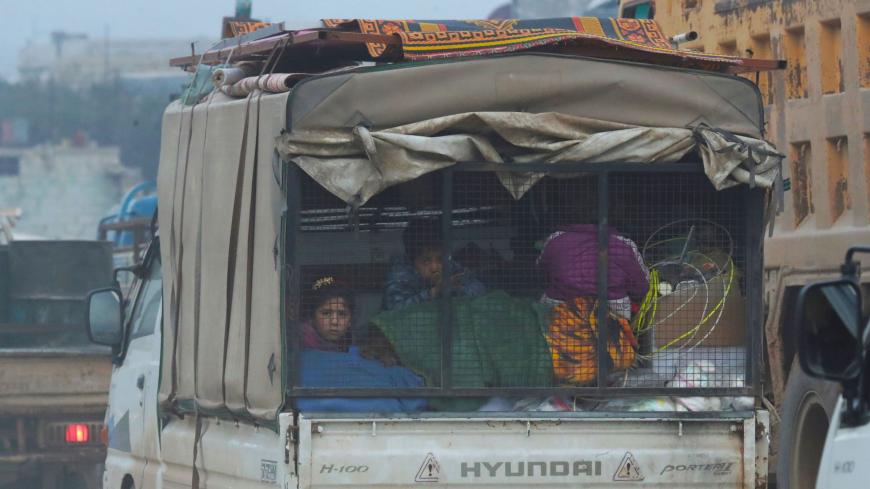IDLIB — As a light rain poured down in the early hours of the morning, vehicles carrying displaced people made their way amid clouds of fog along the road from Idlib to the Syrian-Turkish border. They fled the cities of Idlib province, Arihah and the surrounding countryside as the military offensive of Bashar al-Assad's regime forces, backed by Russian airstrikes, southeast of Idlib province continued.
Stacks of essential necessities brought by the displaced from their homes — blankets, mattresses, clothes and electrical tools — packed the backs of vehicles.
The jammed roads forced cars to move slowly. Loaded vehicles headed to areas adjacent to the Syrian-Turkish border, as empty vehicles headed south toward Idlib and the neighboring towns to carry others.
Syrian regime forces continue their progress in Idlib province despite repeated Turkish warnings. On the evening of Feb. 6, regime forces took control of Saraqeb 17 kilometers (10 miles) east of Idlib city. Turkey had set up four military points in and around Saraqeb in the face of regime advances.
The regime’s control of Saraqeb will test Turkey's seriousness about resorting to a military option, as Saraqeb is strategically located on an important junction of the Aleppo-Damascus M5 highway and the Aleppo-Latakia M4 highway.
15 kilometers separate the regime forces from the complete control of the Aleppo-Damascus M5 highway. On Feb. 9, the regime forces took control of the towns and hills overlooking the M5 road, most notably the towns of Al-Eis (21 km south of the city of Aleppo) and Al-Zorba (15 km south Aleppo).
Turkish President Recep Tayyip Erdogan gave the Syrian regime forces until the end of February to withdraw behind Turkish observation points in northern Syria. “If the Syrian regime will not retreat from Turkish observation posts in Idlib in February, Turkey itself will be obliged to make this happen,” Erdogan said in a speech before the ruling Justice and Development Party in Ankara on Feb. 5. “Turkey’s air and land forces will move freely in all operation areas [in Syria] and in Idlib, and they will conduct operations if needed,” he added.
Turkish threats to the Syrian regime are not reassuring to the residents of Idlib city amid round-the-clock sounds of explosions and shelling coming from the frontlines between the regime and the opposition forces, especially after regime forces took control of al-Nayrab Feb. 4 only 9 kilometers (5 miles) from Idlib city.
Residents have grown even more concerned after Idlib city was subjected to regime airstrikes Feb. 6 that killed eight people, including a medic.
All around the streets of Idlib, a city of 400,000 people, most residents seem to be packing their bags and stacking their belongings into vehicles in preparation for leaving.
Before leaving in a taxi loaded with furniture, Hassan al-Sabouh, 37, told Al-Monitor, “This is the second time within a month that I find myself forced into displacement. I was displaced from Maaret al-Numan, 40 kilometers south of Idlib city, two weeks before the regime forces entered it Jan. 28, and here I am leaving again as regime forces approach Idlib.”
Sabouh added, “I will now head to the Turkish border, near the town of Atma, in the hope of finding a house or a tent there.”
At a time when the Turkish border is still closed, the displaced go mainly to the towns and camps adjacent to the Syrian-Turkish border, in addition to the areas of Afrin and northern Aleppo, controlled by the Turkish-backed opposition.
During Al-Monitor’s tour, many displaced people seemed to have stayed overnight in their cars on the edge of the roads, or inside mosques or schools. Only a few were fortunate to find a house for rent in the border areas.
According to Syria’s Response Coordination Group, 350,000 people were displaced from Idlib province between Jan. 16 and Feb. 4, some of whom were displaced several times as a result of the Syrian regime's military offensive.
Idlib province has been the last destination for civilians and opposition fighters who refused to live within areas controlled by the Syrian regime in various parts of the country. They have been displaced to Idlib province within separate so-called reconciliation deals. The current population in opposition-held areas in Idlib province is estimated at 3.6 million people — 1.7 million of whom are displaced.
As the opposition's control areas recede, the remaining areas do not seem capable of accommodating such a large number of displaced people.
Abdallah al-Suwaid, the emergency response official in the Molham Team for volunteers, told Al-Monitor, “We are working with several organizations to provide temporary shelters for the displaced. They contain large tents for collective housing as a quick solution.”
He added, “Despite all efforts, the displacement movement is several times greater than the capabilities of humanitarian organizations, and we can only accommodate a small portion.”
The residents of Idlib are betting on Turkish diplomatic efforts to stop the ground attack of regime forces, especially after the opposition factions’ counterattacks failed to recover the sites they lost in eastern Idlib — the most recent of which was the Feb. 6 attack on al-Nayrab.
Although the opposition’s Free Syrian Army sent reinforcements to Idlib on Dec. 30, opposition forces could not maintain their strongholds in eastern Idlib.
It appears Russian air cover is a decisive factor in favor of the regime forces during the battles; in addition to the heavy airstrikes, it monitors the movement of opposition fighters and their vehicles through reconnaissance planes.
Meanwhile, the Syrian Observatory for Human Rights documented 13,625 airstrikes by Russian and Syrian warplanes on Idlib province in January.
Turkish Foreign Minister Mevlut Cavusoglu said on Feb. 6 that his country was waiting for Russia to put an end to the escalating regime attacks on Idlib, adding, “We expect a Russian delegation. After the delegation, our President Erdogan and Russian President [Vladimir] Putin will meet if there is a need. Our main aim is to stop conflicts.”






